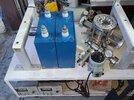ButthairExtraordinaire
New Member
I apologize if I've made this post in the wrong section.
I'm having trouble understanding how I can figure amperage output of a capacitor or if that's even the right way to look at the situation.
I've got two very large capacitors and I'm wondering if there's a significant difference in the amount of effective power output of a small (electrolytic) capacitor vs a very large (oil filled film capacitor) one with the same capacitance and voltage ratings.
For example the two capacitors that I've got are 200ųF and 4kV DC, but when I Google a capacitor with these same specs I don't find anything that looks similar in size to these ones that I've got. So what i'd like to know is, if these capacitors are just less prone to burning out than an electrolytic capacitor of the same specs? Or do they just have more storage capacity?
Heres the math ive done so far, I can tell that these things obviously store a tremendous amount of energy and will definitely be lethal.
½ x (0.0002) x (4,000)² = 1,600
^ ^ ^
Farads x Volts = Joules
0.0002 x 4,000 = 0.8
^ ^ ^
Farads x Volts = Coulombs
Why can a smaller capacitor have all these same characteristics?
I'm having trouble understanding how I can figure amperage output of a capacitor or if that's even the right way to look at the situation.
I've got two very large capacitors and I'm wondering if there's a significant difference in the amount of effective power output of a small (electrolytic) capacitor vs a very large (oil filled film capacitor) one with the same capacitance and voltage ratings.
For example the two capacitors that I've got are 200ųF and 4kV DC, but when I Google a capacitor with these same specs I don't find anything that looks similar in size to these ones that I've got. So what i'd like to know is, if these capacitors are just less prone to burning out than an electrolytic capacitor of the same specs? Or do they just have more storage capacity?
Heres the math ive done so far, I can tell that these things obviously store a tremendous amount of energy and will definitely be lethal.
½ x (0.0002) x (4,000)² = 1,600
^ ^ ^
Farads x Volts = Joules
0.0002 x 4,000 = 0.8
^ ^ ^
Farads x Volts = Coulombs
Why can a smaller capacitor have all these same characteristics?



